The 4F Trauma Personality Types and Recovery
with thanks to @complextraumahealing
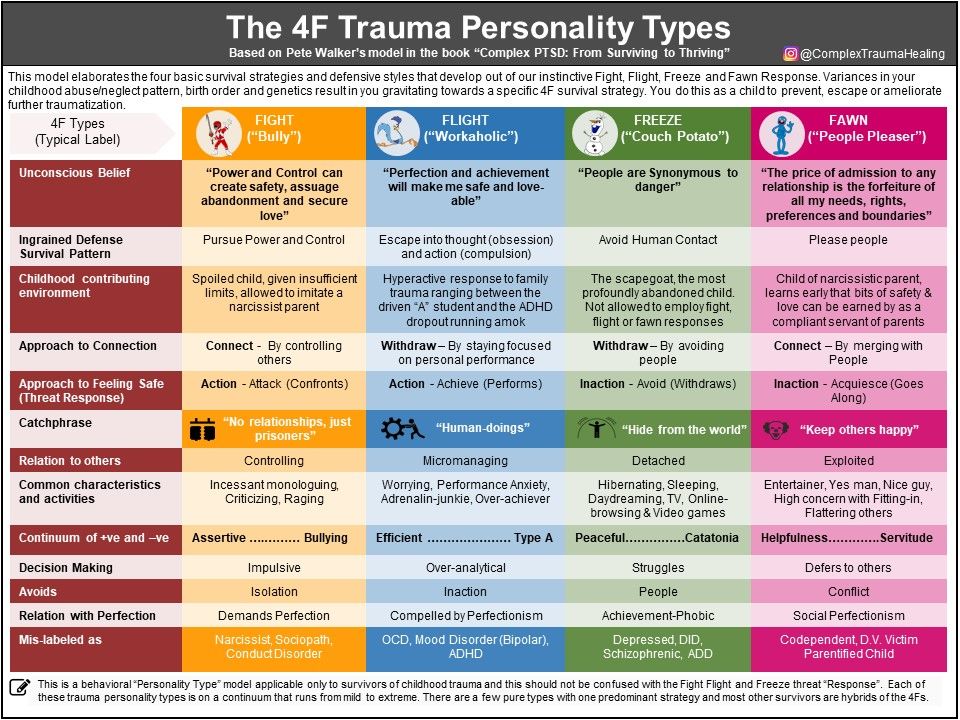
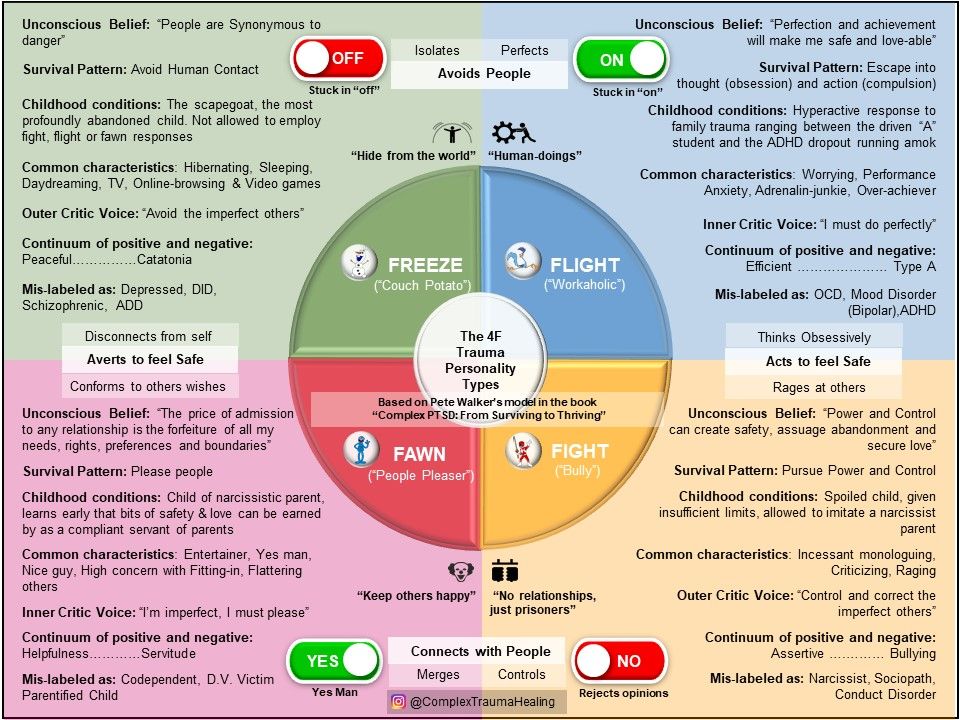
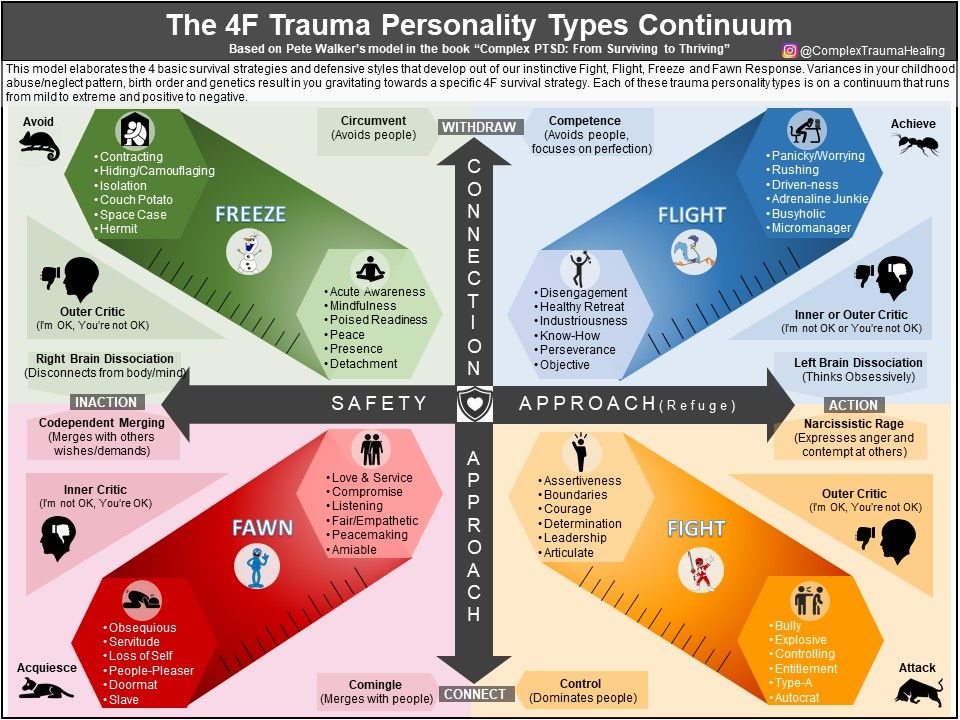
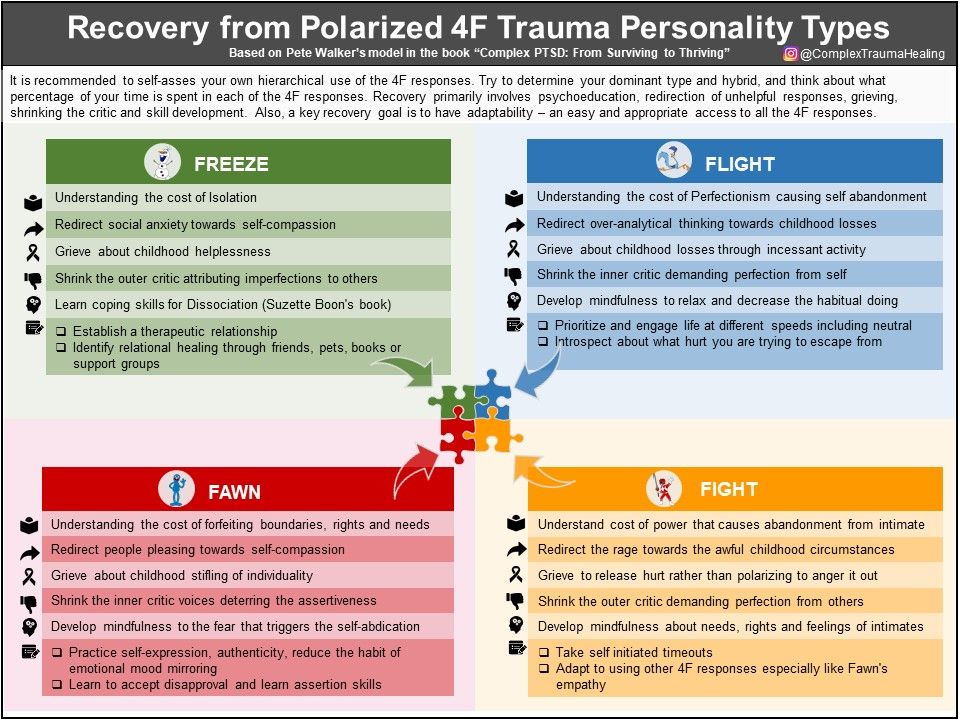
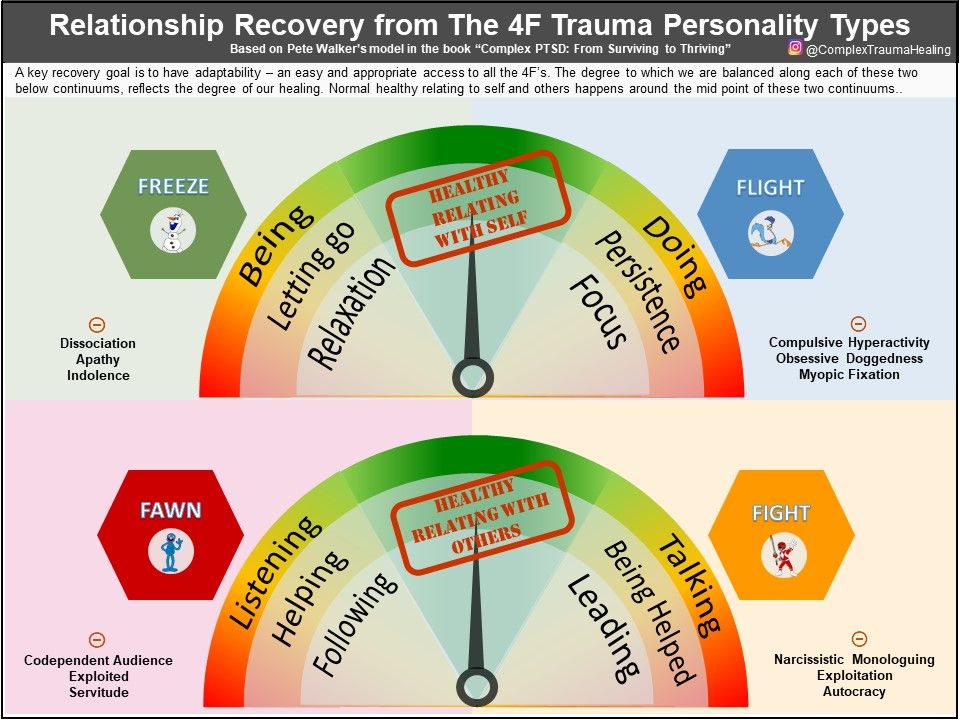
Nurturance through Connection (Love) and Safety (Physical and Emotional) are the primary building blocks of the mental health for a child. However when these two are denied, provided inadequately or with inappropriate limits in childhood, the brain starts to get wired with a predominant focus to avoid the pain of abandonment from the inadequate nurturing connection and the physical/emotional pain imminent from abuse. The adult’s personality as viewed in the context of these two dimensions of “Connection Approach” and “Safety Approach”, reveals a lot about how the personality has shaped around the unconscious beliefs, developed in childhood, though much of which may not be valid in the adult’s environment.
Based on his observations through his years of professional practice and his own childhood trauma recovery journey, Pete Walker has provided a detailed analysis of the four personality types shaped based on the 4F responses available in the child’s environment. He has also provided helpful tips on the approach to recovery for each of the polarized 4F types. This can be a very useful tool for childhood trauma survivors to understand the source of their own behaviour and to start taking effective steps towards recovery. I think that my two years of focused Somatic Experiencing Therapy has yielded more results in healing as compared to the 8 years of a spiritual journey I pursued before the diagnosis. So the diagnosis was an extremely important step in my recovery journey essentially because it narrowed down my area of focus and I could then discover exactly what recovery processes I should enlist myself to rather than continue my devout but hit or miss undertakings. This subdivision of 4F Trauma Personality Types is, on the same note, a further narrowing down of the focus area. This can be a significant help in making conscious choices, for example, to ignore the generic healing resources popping up in our social media feed.
Pete Walker has also suggested the cartoon characters which can be most closely related to the 4F types in his book. I took the liberty of using Olaf (for Freeze) from the movie Frozen which appears to have released just a few weeks before the release of Pete Walker’s book “Complex PTSD: From Surviving to Thriving: A GUIDE AND MAP FOR RECOVERING FROM CHILDHOOD TRAUMA”.
The Fawn (or Please) response type is not part of the traditional Fight Flight or Freeze stress response types, but an important response type necessary to explain the personality traits childhood trauma survivors gravitate towards when only compliance can fetch a few crumbs of relating from their care-givers.
There are a few pure types with one predominant style and most other survivors are hybrids of the 4Fs. I have, very similar to Pete Walker, the FLIGHT trauma 4F style as my predominant type. I have a secondary back up style of FAWN which I employ for selective people in authority positions or as a measure of recovery when a close person is upset with me. My inner critic has kept me too focused on performance at work to continue to feel worthy for most of my adult life. I experienced obsessive thinking (left brain dissociation) every time there was a real or perceived threat of disapproval from the authority figures at work. For a large part of my life I have been inclined to compulsively pursue new hobbies every six months to which some of my college friends still ask me – which “Avatar” are you in this semester ?
There are similarities to this model with the “People (Social) Styles at Work” model explained in the book by Dorothy Bolton and Robert Bolton. The Social Styles model is based on the two externally visible behavioral dimensions of and “Responsiveness” (to connection with people) and “Assertiveness” (in the face of external stress/threat). My employer uses this model extensively to understand clients and also to promote harmonious working relationships. This model was my primary inspiration behind these 4F type graphics. I also came across a DISC model which I am unfamiliar with, however I used it as inspiration to improve the visual appeal for one of the graphic representations in my compulsive (FLIGHT) efforts for perfection.
While it is not necessary or even possible with ordinary efforts to completely change the personality type, there is really nothing right or wrong with each of the types. It takes all kinds to fill the world.
Each of these trauma personality types is on a continuum that runs from mild to extreme. Each of the styles have their own merits which can help individuals to be happy and successful. However it is important to learn adaptability (flexing skill) to use other styles/responses and recover from the polarization towards the unhelpful extremes of ones primary 4F styles.
I must also thank Rivka Levy (spiritualselfhelp.org) for making a graphic out of the 4F Trauma Types which has been very helpful to me and has been the inspiration behind starting to work on these graphics.
I have used the term “Personality Type” in these graphics with the intent to distinguish it from the FIGHT, FLIGHT, FREEZE stress “Response Type” which are available for all human beings. It is not intended to label or box childhood trauma survivors into certain categories. In fact, I have noticed through my past one year of socializing with and being part of support groups that childhood trauma survivors can belong to as many varied personality types as there are.
References:
http://www.pete-walker.com/fourFs_TraumaTypologyComplexPTSD.htm
https://www.spiritualselfhelp.org/blog/january-16th-2017
https://www.slideshare.net/AbdulrhmanTantawy/people-style-at-work
Courses
Let's Create Generational Change Together
To support this goal, Healing from Complex PTSD allows you to:
- Access professional education and business support from industry leaders
- Learn a results-driven approach to CPtsd recovery
- Discover a full library of ready-to-use tools and resources
Developmental Trauma Self-Check
Over the past 12 months, how many and how often have you noticed:
-
I work hard to hold it together in public, then crash in private.
-
I struggle to name what I feel until it overloads me.
-
I say yes to keep the peace, then feel resentful or empty.
-
I feel loyal to people who do not treat me well.
-
I lose time or feel foggy when stressed.
-
I avoid closeness or over-attach quickly, then panic.
-
I find it hard to trust my own judgement.
-
I feel shame when I try to set boundaries.
-
I need external approval to feel steady.
-
I push through fatigue instead of pausing.
How to use this:
0–3 items often: you may be using a few survival patterns.
4–7 items often: consider paced support to rebuild safety and choice.
8–10 items often: a trauma-trained professional can help you restore stability and connection.
Brain Impact Self-Check
Over the past 12 months, how often have you noticed:
-
My mind jumps to what could go wrong, even in safe moments.
-
I find it hard to remember recent details when I am stressed.
-
Decisions feel risky, so I delay or avoid them.
-
I forget good experiences quickly and dwell on the bad.
-
I feel numb or overwhelmed, with little in-between.
-
I lose words when emotions rise.
-
I misread neutral faces or tones as negative.
-
I struggle to notice body signals like hunger, tension or breath.
-
I do better when someone I trust is nearby.
-
I feel different “versions” of me in different settings.
How to use this:
0–3 often: some protective habits; gentle self-care may help.
4–7 often: consider trauma-trained coaching to build daily brain skills.
8–10 often: a paced, brain-based plan can restore clarity, memory and confidence.
For formal assessment, use recognised measures:
-
ACE-IQ or ACE-10 for adversity history (education only on public pages).
-
ITQ (International Trauma Questionnaire) for ICD-11 PTSD/Complex PTSD.
-
DERS for emotion regulation, DES-II for dissociation, PCL-5 for PTSD symptoms.
-
PHQ-9, GAD-7 for mood and anxiety; OSSS-3 for social support.

